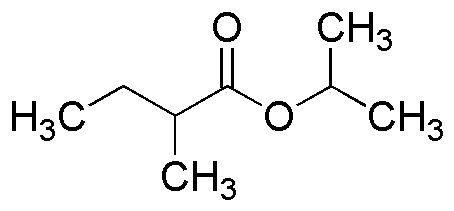Isopropyl 2-methylbutyrate is widely utilized in research focused on:
- Flavoring and Fragrance Industry: This compound is commonly used as a flavoring agent in food products and beverages, providing a fruity aroma that enhances sensory appeal.
- Cosmetic Formulations: It serves as a solvent and fragrance component in cosmetics and personal care products, contributing to the overall scent and texture.
- Pharmaceutical Applications: In the pharmaceutical industry, it acts as a solvent for various active ingredients, improving the solubility and bioavailability of medications.
- Chemical Synthesis: Researchers use it as an intermediate in organic synthesis, facilitating the production of more complex molecules in laboratory settings.
- Industrial Cleaning Products: Its properties make it effective in formulating cleaning agents, where it helps dissolve oils and greases, making it valuable in industrial cleaning applications.
General Information
Properties
Safety and Regulations
Applications
Isopropyl 2-methylbutyrate is widely utilized in research focused on:
- Flavoring and Fragrance Industry: This compound is commonly used as a flavoring agent in food products and beverages, providing a fruity aroma that enhances sensory appeal.
- Cosmetic Formulations: It serves as a solvent and fragrance component in cosmetics and personal care products, contributing to the overall scent and texture.
- Pharmaceutical Applications: In the pharmaceutical industry, it acts as a solvent for various active ingredients, improving the solubility and bioavailability of medications.
- Chemical Synthesis: Researchers use it as an intermediate in organic synthesis, facilitating the production of more complex molecules in laboratory settings.
- Industrial Cleaning Products: Its properties make it effective in formulating cleaning agents, where it helps dissolve oils and greases, making it valuable in industrial cleaning applications.
Documents
Safety Data Sheets (SDS)
The SDS provides comprehensive safety information on handling, storage, and disposal of the product.
Product Specification (PS)
The PS provides a comprehensive breakdown of the product’s properties, including chemical composition, physical state, purity, and storage requirements. It also details acceptable quality ranges and the product's intended applications.
Certificates of Analysis (COA)
Search for Certificates of Analysis (COA) by entering the products Lot Number. Lot and Batch Numbers can be found on a product’s label following the words ‘Lot’ or ‘Batch’.
*Catalog Number
*Lot Number
Certificates Of Origin (COO)
This COO confirms the country where the product was manufactured, and also details the materials and components used in it and whether it is derived from natural, synthetic, or other specific sources. This certificate may be required for customs, trade, and regulatory compliance.
*Catalog Number
*Lot Number
Safety Data Sheets (SDS)
The SDS provides comprehensive safety information on handling, storage, and disposal of the product.
DownloadProduct Specification (PS)
The PS provides a comprehensive breakdown of the product’s properties, including chemical composition, physical state, purity, and storage requirements. It also details acceptable quality ranges and the product's intended applications.
DownloadCertificates of Analysis (COA)
Search for Certificates of Analysis (COA) by entering the products Lot Number. Lot and Batch Numbers can be found on a product’s label following the words ‘Lot’ or ‘Batch’.
*Catalog Number
*Lot Number
Certificates Of Origin (COO)
This COO confirms the country where the product was manufactured, and also details the materials and components used in it and whether it is derived from natural, synthetic, or other specific sources. This certificate may be required for customs, trade, and regulatory compliance.


